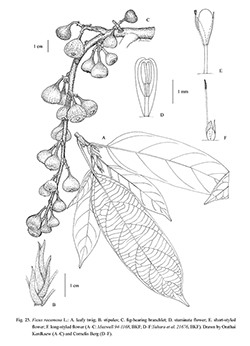e-Flora of Thailand
Volume 10 > Part 4 > Year 2011 > Page 569 > Moraceae > Ficus
SYO10. Ficus racemosa L.wfo-0000689977
Sp. Pl.: 1060. 1753; Miq., Ann. Mus. Bot. Lugd.-Bat. 3: 296. 1867; Kochummen, Tree Fl. Malaya 3: 154. 1978; Kochummen, Tree Fl. Sabah & Sarawak 3: 297. 2000; C.C.Berg & Corner, Fl. Males., Ser. 1, Spermat. 17(2): 339. 2005; G.Zhang et al., Biotropica 33: 334. 2006; Upadhyay & Srivastava, Taxon 59: 1879. 2010. Fig 25. Plate LXVI: 1–2.
Accepted Name : This is currently accepted.
Synonyms & Citations :
Description : Tree to 20(–)30 m tall, becoming buttressed, deciduous; latex white, cream, or pinkish. Leafy twigs 1.5–3 mm thick, sparsely to densely appressed-puberulous; internodes solid; periderm flaking off. Leaves spirally arranged (to subdistichous); lamina oblong, lanceolate, or subovate (or to subobovate), (2–)6–20 by (1–)3–9 cm, symmetrical, (sub)coriaceous, apex (sub)acuminate to subacute, base cuneate to rounded (to subcordate), margin entire, sometimes (faintly) irregularly dentate or sublobate; upper surface sparsely pilose and glabrescent or appressed-puberulous on the midrib, smooth, lower surface sparsely pilose and glabrescent or appressed-puberulous on the main veins; cystoliths only below; lateral veins 4–9(–12) pairs, the basal pair ± distinct, unbranched or faintly and sparsely branched, tertiary venation scalariform; waxy glands in the axils of the basal pair of lateral veins, often inconspicuous; petiole 1.5–7 cm long, (sub)glabrous or appressed-puberulous, the epidermis flaking off; stipules 0.5–1.2 cm long, sparsely to densely appressed-puberulous to subtomentose or only ciliolate, subpersistent or caducous. Figs on clusters of to ca 25 cm long, often branched, leafless branches on the older wood, down to the trunk; peduncle 0.3–1.2 cm long; basal bracts 3, 1–2 mm long, persistent; receptacle subglobose to subpyriform, 1.5–3 cm diam. when dry, 3–5 cm diam. when fresh, puberulous, without lateral bracts, pinkish to purple-red or orange at maturity, apex flat to slightly concave, ostiole ca 3 mm diam., prominent; internal hairs absent.
Thailand : NORTHERN: Chiang Mai, Chiang Rai, Lamphun, Lampang, Phrae, Tak, Phitsanulok; SOUTH-WESTERN: Kanchanaburi; CENTRAL: Lop Buri, Saraburi, Nakhon Nayok; SOUTH-EASTERN: Chanthaburi; PENINSULAR: Songkhla, Narathiwat.
Distribution : Sri Lanka, Pakistan, India (type), Nepal, Sikkim, Bangladesh, Burma, S China, Vietnam, Laos, Cambodia, Peninsular and Bornean Malaysia, Indonesia (Sumatra, Java, Kalimantan, Sulawesi, Lesser Sunda Islands, Papua), Australia.
Ecology : Mixed deciduous, dry evergreen and evergreen forests, to 1,000 m alt.
Vernacular : Ku-sae (กูแซ)(Karen-Mae Hong Son); duea kliang (เดื่อเกลี้ยง)(Central, Northern); duea nam (เดื่อน้ำ)(Peninsular); ma duea (มะเดื่อ)(Lampang); ma duea chumphon (มะเดื่อชุมพร), ma duea utumphon (มะเดื่ออุทุมพร)(Central).


